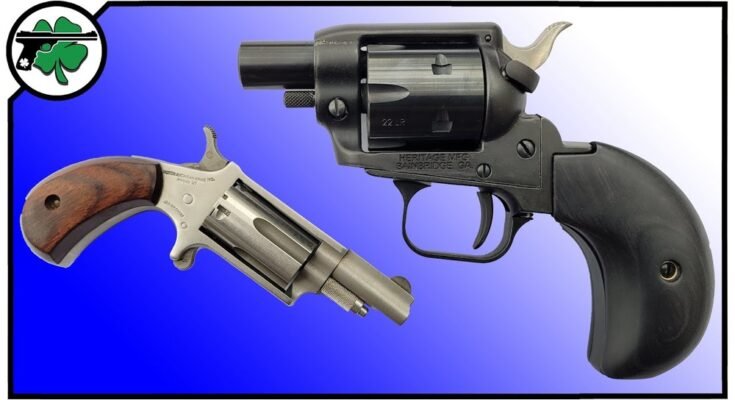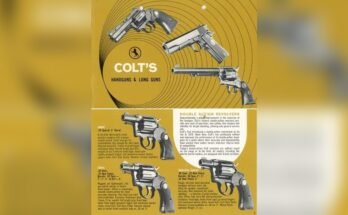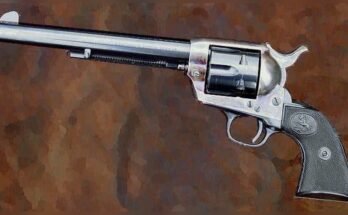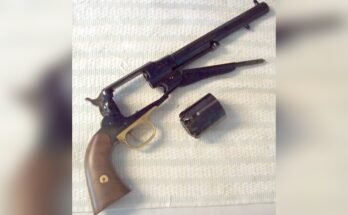If you own or handle a fixed cylinder revolver, knowing how to unload it safely is crucial. You might think it’s simple, but one wrong move can lead to serious trouble.
This guide will walk you through each step clearly and confidently, so you can protect yourself and those around you. By the end, you’ll feel in control every time you handle your revolver. Ready to learn the safest way to unload your fixed cylinder revolver?
Let’s dive in.
Safety First
Start by pointing the revolver in a safe direction. Open the cylinder and carefully remove each cartridge one by one. Always check twice to ensure the gun is fully unloaded before handling further.
Wear Protective Gear
Safety starts with wearing the right gear. Always wear eye protection. Small sparks or debris can cause injury. Ear protection is also important to protect your hearing. Gloves help protect your hands from dirt and sharp edges. Never handle a revolver without these basic protections. They reduce risks and keep you safe during unloading.
Ensure A Safe Environment
Choose a clear, open space for unloading. Keep the area free of distractions and bystanders. Make sure no one is in front of the revolver’s muzzle. Point the gun in a safe direction at all times. Check that the surface is stable and well-lit. This helps prevent accidents and allows you to focus on the task. Safety is the top priority in every step.
Check The Revolver
Before unloading a fixed cylinder revolver, it is important to check the firearm carefully. This step helps ensure safety and proper handling. Knowing the details of your revolver can prevent accidents.
Take your time and focus on the task. Checking the revolver prepares you for the next steps in unloading.
Identify The Cylinder Type
Look closely at the cylinder of your revolver. A fixed cylinder does not swing out or open like other types. It stays in place when you fire or reload. This design means you must remove each cartridge one by one.
Knowing the cylinder type helps you understand how to unload safely. It also tells you what tools or actions you may need.
Confirm The Firearm Is Pointed Safely
Always make sure the revolver points in a safe direction. This means away from people, pets, or anything that could be damaged. Even if you think the gun is unloaded, treat it as if it can fire.
Keeping the firearm pointed safely reduces the risk of injury. Safety is the top priority when handling any gun.
Open The Cylinder
Opening the cylinder is the first step to unload a fixed cylinder revolver. This action allows access to the chambers holding the cartridges. Knowing how to open it safely is important for handling the firearm properly.
Each revolver model may have a slightly different way to open the cylinder. Understanding your revolver’s mechanism helps avoid damage and ensures safe unloading.
Locate The Release Mechanism
Start by finding the release mechanism on your revolver. It is often a small latch or button near the cylinder. This part unlocks the cylinder so it can move freely.
Look carefully around the frame close to the cylinder. Press or slide the release to unlock the cylinder. This step must be done gently to prevent any damage.
Swing Out Or Rotate The Cylinder
Once unlocked, the cylinder either swings out or rotates to open. Some revolvers have a side swing-out cylinder that moves outward. Others rotate the cylinder around a fixed axis.
Gently swing or rotate the cylinder to expose all chambers. This position allows you to see and remove the cartridges easily. Always keep the revolver pointed in a safe direction during this process.
Remove The Ammunition
Removing the ammunition from a fixed cylinder revolver is a key safety step. It helps prevent accidental firing and keeps the gun ready for cleaning or storage. This process involves two main tasks: ejecting the cartridges and checking each chamber to ensure it is empty.
Eject Cartridges Using The Ejector Rod
Start by opening the revolver’s cylinder. Hold the gun firmly and push the ejector rod. The rod pushes out all the cartridges at once. Use your fingers to remove them from the cylinder. Make sure to push gently and steadily. Avoid forcing the rod, which could damage the gun.
Inspect Each Chamber
Look carefully inside each chamber of the cylinder. Check for any remaining cartridges or debris. Use a flashlight if needed to see clearly. Run your finger or a cleaning tool through each chamber. Confirm that all ammunition is removed. This step ensures the revolver is safe and ready for the next use.
Verify The Chambers
Verifying the chambers is a key step in unloading a fixed cylinder revolver. It ensures the gun is safe to handle and no rounds remain inside. This step reduces the risk of accidental discharge during cleaning or storage.
Take your time and carefully check each chamber. Don’t rush this part. Your safety depends on it.
Visually Check Each Chamber
Open the cylinder fully to see each chamber clearly. Use good lighting to spot any cartridges or debris. Look down the barrel side to confirm each chamber is empty. A quick glance can miss a round, so be thorough.
Physically Feel For Obstructions
Run your finger gently inside each chamber to feel for anything stuck. Sometimes dirt or a casing fragment can block a chamber. Feeling carefully helps detect hidden obstructions. This step is important for safe unloading and proper revolver function.
Close The Cylinder
Closing the cylinder is a key step in safely unloading a fixed cylinder revolver. This action ensures the firearm is ready for the next step or for safe storage. Properly closing the cylinder prevents dirt and debris from entering and keeps the revolver in good working order.
Take your time and handle the revolver carefully. A secure and aligned cylinder helps avoid damage and ensures smooth operation.
Align The Cylinder Properly
Hold the revolver firmly with one hand. Use your other hand to gently push the cylinder back into the frame. Make sure each chamber lines up with the barrel. Misalignment can cause problems when closing the cylinder. Check that the cylinder rotates freely and clicks into place smoothly.
Secure The Cylinder In Place
Once aligned, press the cylinder firmly against the frame. You should hear a soft click. This sound means the cylinder locks securely. Avoid forcing the cylinder closed. If it does not close easily, recheck the alignment. A properly secured cylinder keeps the revolver safe and ready for use.
Final Safety Checks
After unloading a fixed cylinder revolver, final safety checks are crucial. These steps ensure the gun is safe and ready for storage. Taking time for these checks prevents accidents and keeps the firearm in good condition.
Perform A Dry Fire Test
First, perform a dry fire test. Point the revolver in a safe direction. Pull the trigger without any ammunition. This action confirms the gun is empty. It also checks the trigger and hammer work properly. Dry firing helps spot any mechanical issues early.
Store The Revolver Safely
Next, store the revolver safely. Use a locked case or safe. Keep the gun away from children and unauthorized users. Store it in a dry place to avoid rust. Proper storage protects both you and the revolver.


Frequently Asked Questions
How Do You Safely Unload A Fixed Cylinder Revolver?
To unload, open the loading gate and rotate the cylinder manually. Eject each cartridge carefully using the ejector rod. Ensure the firearm points in a safe direction throughout the process.
What Tools Are Needed To Unload A Fixed Cylinder Revolver?
No special tools are required. Use your hands to open the loading gate and the ejector rod to remove cartridges. Always handle the revolver with care and follow safety protocols.
Can You Unload A Fixed Cylinder Revolver With The Hammer Cocked?
It’s safer to unload with the hammer down. This reduces accidental discharge risk. Always keep your finger off the trigger and the gun pointed away while unloading.
How To Identify If A Fixed Cylinder Revolver Is Fully Unloaded?
Visually inspect each chamber by rotating the cylinder. Look for any remaining cartridges. Double-check by feeling with your finger if necessary, ensuring the revolver is completely empty.
Conclusion
Unloading a fixed cylinder revolver is simple and safe. Open the cylinder fully to see all chambers. Push out each cartridge carefully with your thumb or a rod. Always check twice to ensure no rounds remain inside. Practice this process slowly to build confidence.
Safety comes first with every step you take. Keep your revolver clean and well-maintained for smooth operation. Understanding these steps helps you handle your firearm responsibly. Stay calm and focused while unloading. Safety and care protect you and others around you.



